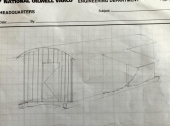
 5
5




![Filename: 9780881790108-us-300.jpg
Description: [Thumbnail for 9780881790108-us-300.jpg]](/t/214007/a/264690/9780881790108-us-300.jpg)
 4
4




Tommy Bolin wrote:The prefab rail setup for the first cut is the limiting length for a Granberg type mill. I avoided this type of equipment for the cost and length limitation. I use a setup of string, nails, level and sliding board. I have milled well over 20ft lengths with my chainsaw.
If it interests anyone, I can create a drawing of how this works.
"Ah, but a man's reach should exceed his grasp,
Or what's a heaven for?"
Andrea del Sarto by Robert Browning
 4
4




Steve Zoma wrote:
I know it would seem a sawmill make a flat cut, but that is not the case. A lot of forces are at play, and a lot of different densities play into the cut. Cut a log with some knots and the sawblade deflects rising and falling. Or the weight of the log compresses the frame of the sawmill so that as a cut is made, you end up with a deeper cut in the middle of the log than the ends. It is just impossible to make a flat cut with a sawmill, that is why all commercial wood is put through a planer, at least on one side.
 5
5




Coydon Wallham wrote:Going back to the original concept, what would be the easiest way to get longer logs with two flats?.
"Ah, but a man's reach should exceed his grasp,
Or what's a heaven for?"
Andrea del Sarto by Robert Browning
 3
3




Kevin Olson wrote:Enduring Scandinavian structures were also commonly built with Scotch pine logs which had dried down on the stump. Ring bark the tree, either just below the crown (seems to have been preferred, even if more difficult - shinnying up 30 meters or so without the benefit of modern safety gear would be a bit perilous) or girdle at the base of the tree, and let it die on the stump, or skin off bark with a long-handled spud blade, either in strips or patches up the length of the stem. The intent of both approaches is to turn the entire stem into resinous "fat wood", so that it is completely saturated with hardened pine pitch. It could require up to 3 years to do the process properly so that the log was ready to harvest.
Become extra-civilized!
 4
4




Coydon Wallham wrote:Following up on a different vein, do any of your sources expand on this process?
"Ah, but a man's reach should exceed his grasp,
Or what's a heaven for?"
Andrea del Sarto by Robert Browning
 5
5




"Ah, but a man's reach should exceed his grasp,
Or what's a heaven for?"
Andrea del Sarto by Robert Browning
 3
3




Tommy Bolin wrote:Going back to the original concept, what would be the easiest way to get longer logs with two flats?
"Ah, but a man's reach should exceed his grasp,
Or what's a heaven for?"
Andrea del Sarto by Robert Browning

|
meow meow meow tiny ad meow meow
Play Your Way to a Sustainable Lifestyle: Uncover Permaculture Principles with Each Card
https://gardener-gift.com/
|






